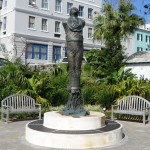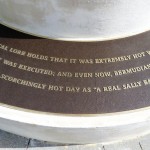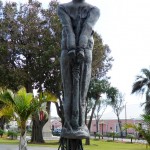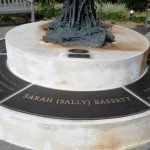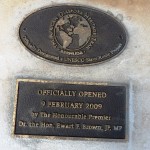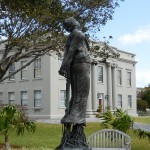Sally Bassett
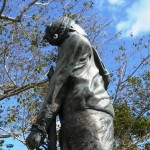 A symbolic figure in Bermuda’s history, Sarah Sally Bassett was a slave “owned” by the estate of Francis Dickinson of Southampton in the 18th century.
A symbolic figure in Bermuda’s history, Sarah Sally Bassett was a slave “owned” by the estate of Francis Dickinson of Southampton in the 18th century.
Said to be an elderly mulatto woman, Sally became the ‘”property” of Thomas Forster [who also "owned" her grandaughter Beck] after Dickinson’s death in 1727.
Sally was charged with supplying Beck with poison discovered in the wall of the kitchen. The poison was said to be ‘ratsbane’ and ‘manchioneel root’.
She was charged with “suspicion of poisoning several persons”, including Thomas Forster, his wife Sarah Forster, and Nancey, a household bondswoman. Nancey was said to have found the poison and turned Sally in.
She was found guilty on June 5 and sentenced:
To be convey’d to the place of execution where a pile of wood is to be made and provided and you are thereto be fastene’d to a sufficient stake and there be burnt with fire until your body be dead.
Despite maintaining her innocence till her death, she was burned at the stake on June 6th 1730 in a public display at the Foot of the Lane at the eastern end of Hamilton Harbour.
On her way to her execution, she is reputed to have said to crowds rushing to witness the event to take their time because “There’ll be no fun ’til I get there.”
At the time of her death Sally was valued at one pound, four shillings and sixpence [around $160 in today’s currency according to the UK National Archives]
Folklore says that the day Sally was executed was an extremely hot day, and hence some Bermudians refer to a really hot day as a ‘Sally Bassett Day’. Another local legend says that Bermuda’s national flower, the Bermudiana, grew from Sally’s ashes.
In 2008 a ten feet tall statue of Sally Bassett was erected on the Cabinet office grounds in Hamilton.
The statue was initially slated to be located at City Hall, a subject of great controversy between City Hall and the ruling PLP Government. The Corporation of Hamilton, lead by Hamilton Mayor Sutherland Madeiros, blocked the memorial for logistical reasons citing space concerns. Several members of the PLP were reportedly furious, feeling the mostly white Corporation of Hamilton actually blocked the memorial as a snub.
The statue was eventually placed in the Cabinet grounds, rather then City Hall. Officially commemorated by Premier Dr. Ewart Brown on February 9, 2009, it became the first time a slave has been memorialized in Bermuda. The statue is the work of Bermudian artist Carlos Dowling.
Former Premier of Bermuda Dame Jennifer Smith said of the memorial:
It has often been said that slavery|in Bermuda was ‘benign’. The Sally Bassett story puts aside this myth; slavery by its nature can not be benign.
Governor Sir Richard Gozney:
Sally Bassett was clearly a significant figure in the history of Bermuda. She is a figure who is still respected, and who serves as an icon for many people on the Island.
Premier Dr Ewart Brown:
The Sally Bassett monument is about ensuring everyday that the story of Sally Bassett lasts at least until tomorrow.
Click to enlarge images:
In 2010, Bermudian author Colwyn Burchall Jr. released “Freedom’s Flames: Slavery in Bermuda and The True Story of Sally Bassett.”
Mr Burchall said the book “looks at why Sally Bassett “took the actions that she is alleged to have taken. What was going on in Bermuda in the 1700s that might have driven an elderly mulatto enslaved person to attempt to poison her grandaughter Beck’s owners.”

